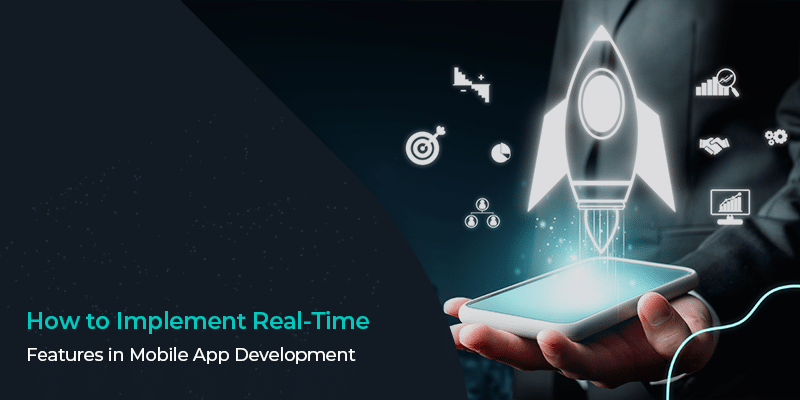The digital world’s fast speed makes real-time features essential requirements for mobile applications during this present era. The integration of real-time functionalities through live chat, notifications, collaborative tools, and location tracking enables a better user experience and increases user engagement.
Technical implementation of these features needs appropriate frameworks together with technologies and proper strategies. App developers need to guarantee application scalability alongside enhanced security measures and the best performance possible during real-time functionality implementation.
Key Real-Time Features to Implement
- Notifications & Alerts – Immediate notification updates about messages, transactions, and system modifications.
- Chat & Messaging – WebSockets or Firebase is used by any premium app development company to create real-time and instant communication channels.
- Location Tracking – Important for apps that use trackers for delivery, logistics, or cab-hailing services.
- Streaming & Video Calls – UK developers often use WebRTC for delivering high-quality low-latency video and call features in apps.
- Data Syncing – Offers a wide and updated cloud storage with collaborative work features.
- Dynamic Pricing & Stock Updates – Plays an essential role in eCommerce stores, fintech organizations, and trading applications.
- Interactive Polls & Feedback – Increases user engagement in entertainment and social networking app development.
- IoT & Smart Device Control – The Real-time automation system controls connected smart devices.
What Are The Best Practices For Real-Time Implementation In Mobile App Development
Performance Optimization
Mobile applications require design features that promote high-speed performance along with scalability to achieve real-time operational success. A combination of efficient resource administration with optimized network connectivity systems stops system crashes and slow response times.
- Application performance is enhanced through traffic-distributing capabilities by any experienced app agency in the US.
- Content Delivery Networks (CDNs) should be used to minimize latency and improve response times.
- Database queries need optimization to avoid delays that slow down data access and retrieval periods.
- Strategic deployment of event-driven architectures with microservices handles real-time updates in the system.
Data Security & Privacy
Timeout-based programs depend on protecting user-sensitive information since their primary focus is security. The combination of encryption methods, authentication protocols, and access control procedures assists in protecting data from breaches while securing it against unauthorized usage.
- When sending real-time messages and recording videos with users employ encryption that extends from end to end.
- To shield user data users must employ security authentication protocols which include OAuth and JWT tokens.
- System security should be updated frequently to protect real-time systems from developing vulnerabilities.
- RBAC should function as the methodology for restricting changes to sensitive information from unauthorized users.
Minimize Battery & Data Consumption
Applications operating in real-time measure usually maintain a continuous operation that both depletes battery power and raises data consumption levels. The optimized utilization of resources helps maintain performance levels while users continue to experience high-quality functions.
- Efficient applications and less battery usage result from optimizing background tasks.
- Your application should use JSON and Protocol buffer data formats to reduce network bandwidth usage.
- Differential data syncing methods should transmit altered data points instead of Whole data transmissions.
- The system should automatically adjust its polling schedule to find the right balance between speed and electric power usage.
Test Reliability and Low Latency
Real-time applications demand speedy performance alongside reliable systems because user experience becomes negatively affected by any delays or system failures. Prior to deployment testing reveals all potential problems within the system. Follow these best practices:
- Tests must analyze how the application behaves under conditions with very heavy user actions.
- Real-time traffic monitoring tools help identify and address bottlenecks in the system.
- Real-time application functionality must be tested through simulated real-world usage scenarios under various network conditions.
- A system with automatic failover functions provides uninterrupted service and prolonged operational duration.
Choose the Right Tech Stack
Efficiency levels in real-time implementation depend heavily on the selection of proper technology solutions. A perfect mix of backend technologies with communication methods paired with frontend construction results in uncomplicated user experiences. Consider these options:
- Scalable real-time processing requires backend solutions which include Node.js, Firebase, or AWS Lambda.
- Chat applications together with IoT need WebSockets or MQTT for effective two-way communication.
- Interactive applications benefit from the use of GraphQL subscriptions to achieve real-time updates of data.
- Frontend development tools such as React Native and Flutter support live user interface modernization.
Successful Error Management
All real-time applications require elegant error handling to avoid system interruptions. Real-time monitoring through logging technologies permits proactive identification followed by immediate resolution of system issues. The following best practices represent-effective methods to handle errors:
- Develop a system for real-time logging that records events both for debugging needs and performance analysis.
- The system must carry out retry procedures when network requests fail to maintain message delivery.
- The implementation of alerts with system failure notification will let you handle issues before they become severe problems.
- A process to detect and examine running errors allows developers to enhance stability improvements continuously.
Conclusion
Mobile app performance alongside security and efficiency depend on a deliberate strategy to implement real-time features. You should begin execution of these best practices at this moment to create smooth real-time mobile applications that users will enjoy.



